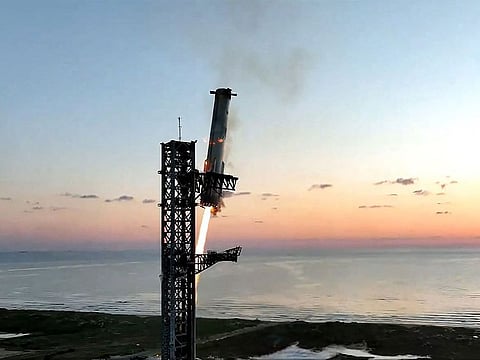Video: In a first, SpaceX 'catches' megarocket booster after test flight
SpaceX has launched Starship, the most powerful rocket, on its fifth test flight

Boca Chica: SpaceX successfully "caught" the first-stage booster of its Starship megarocket Sunday as it returned to the launch pad after a test flight, a world first in the company's quest for rapid reusability.
The "super heavy booster" had blasted off attached to the Starship rocket minutes earlier, then made a picture perfect controlled descent to the same pad in Texas where a pair of "chopsticks" reached out from the launch structure to bring the slowly descending booster to a halt, according to a livestream from Elon Musk's SpaceX company.
The largest and most powerful rocket ever developed lifted off at 8:25 a.m. New York time. After propelling Starship to space, the Super Heavy booster returned to its launch site on Earth, where it slowed itself down as it came in for landing. Two arms protruding from Starship's launch tower then "caught" the booster as it lowered itself down to the ground, as cheers and applause erupted at mission control.
The largest and most powerful rocket ever developed lifted off at 8:25 a.m. New York time. After propelling Starship to space, the Super Heavy booster returned to its launch site on Earth, where it slowed itself down as it came in for landing. Two arms protruding from Starship's launch tower then "caught" the booster as it lowered itself down to the ground, as cheers and applause erupted at mission control.
"I am still in disbelief," Jessie Anderson, a SpaceX engineer said during the live webcast. "I'm trying to catch my tears just like the chopsticks caught the booster."
Recovering Starship's booster after launch is a crucial milestone for SpaceX as it readies the rocket for commercial operations. The vehicle is the centerpiece of SpaceX Chief Executive Officer Elon Musk's ambitions of sending people to the moon and Mars. But it has a long road ahead before it launches crew and cargo.
Musk has long touted that the vehicle will be fully reusable. The company is known for recovering its workhorse Falcon 9 rockets after launch, but those spacecraft are only partly reusable, with a portion of the vehicles still being destroyed or left unused after the mission is over.
With Starship, SpaceX's eventual aim is to fully recover the vehicle's two main parts: the Starship spacecraft itself "- which will carry satellites and eventually passengers "- and the Super Heavy booster.
By recovering both of these pieces after flight, SpaceX hopes to rapidly reuse and relaunch the hardware following takeoff, allowing for multiple flights of Starship in a single day. The company also expects full reusability to drastically lower the cost of launching Starship.
Like the Falcon 9, Starship's Super Heavy booster came back to Earth using fins to help guide it through the atmosphere. It reignited its engines to help lower itself down to the ground slowly. But unlike the Falcon 9 "- which lands on a hard surface with a set of landing legs "- Super Heavy was caught just before it touched the ground.
Sunday's flight was the first time that SpaceX attempted this feat with Super Heavy. On Starship's fourth flight in June, the company attempted to "land" Super Heavy in the Gulf of Mexico, aiming for a pinpoint target in the ocean.
The mission unfolded against the backdrop of Musk openly criticizing the speed at which the FAA approves commercial space launch licenses. SpaceX has been raising the concern in recent years as it tries to launch Starship more frequently. In September, the company said the FAA notified it that the license for this mission wouldn't be granted until late November "- a timeline that SpaceX said was slow and inefficient.
Apart from the booster catch, Starship's flight looked fairly similar to its June flight. SpaceX launched the Starship and Super Heavy booster together. Starship then circled most of the globe before plunging through the atmosphere, its body engulfed in the reddish orange glow of plasma as it hurtled back to Earth.
Some of its flaps "- which help it steer "- appeared to burn up slightly during the vehicle's descent, according to the webcast. But Starship appeared to survive the plunge, before flipping itself and reigniting its engines to splash down in the Indian Ocean. It then appeared to explode.
During the last flight, Starship survived much of the descent to Earth, but started to break apart during the fall and eventually burned up completely before it could hit the ocean. SpaceX said it reworked the heat shield on Starship for this flight to help it withstand the intense heating it experiences while falling through the atmosphere.
With each of these Starship test flights, SpaceX doesn't necessarily deem the loss of its vehicles as failures. The goal for the company is to continue improving with each subsequent test flight. So far, the company has been able to achieve more goals with every new launch.
Sign up for the Daily Briefing
Get the latest news and updates straight to your inbox



